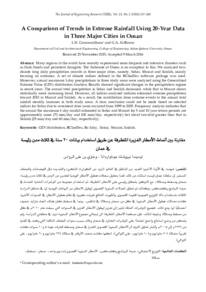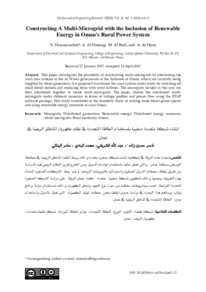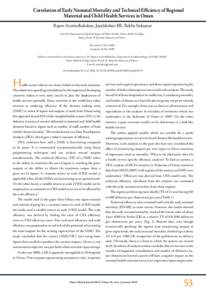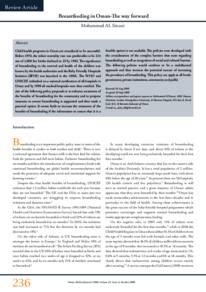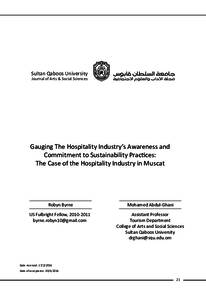Document
A comparison of trends in extreme rainfall using 20-year data in three major cities in Oman.
Contributors
Al-Rawas, G. A., Author
Publisher
Sultan Qaboos University.
Gregorian
2016
Language
English
English abstract
Many regions in the world have recently experienced more frequent and intensive disasters such as flash floods and persistent droughts. The Sultanate of Oman is no exception to this. We analyzed twodecade long daily precipitation records in three major cities, namely, Sohar, Muscat and Salalah, mainly focusing on extremes. A set of climate indices defined in the RClimDex software package was used. Moreover, annual maximum 1-day precipitations in three study areas were analyzed using the Generalized Extreme Value (GEV) distribution function. Results showed significant changes in the precipitation regime in recent years. The annual total precipitation in Sohar and Salalah decreased, while that in Muscat shows statistically week increasing trend. However, all indices analyzed indicate enhanced extreme precipitation toward 2010 in Muscat and Salalah. As a result, the contribution from extreme events to the annual total rainfall steadily increases in both study areas. A clear conclusion could not be made based on selected indices for Sohar due to consistent drier years occurred from 1999 to 2005. Frequency analysis indicates that the annual the maximum 1-day rainfall estimated in Sohar and Muscat for 5 and 10 year return periods are approximately same (70 mm/day and 108 mm/day, respectively) but about two-fold greater than that in Salalah (29 mm/day and 60 mm/day, respectively).
Member of
ISSN
1726-6742
Resource URL
Citation
Gunawardhana, L. N., & Al-Rawas, G. A. (2016). A comparison of trends in extreme rainfall using 20-year data in three major cities in Oman. The Journal of Engineering Research, 13 (2), 137-148.
Arabic abstract
شهدت في الآونة الأخيرة العديد من المناطق في العالم المزيد من الكوارث المتكررة والشديدة مثل الفيضانات والجفاف المستمر، إن سلطنة عمان ليست استثناء من ذلك. قمنا بتحليل سجلات هطول الأمطار اليومية لعقدين من الزمن في ثلاث مدن رئيسة : صحار ومسقط وصلالة، مع التركيز بشكل رئيسي على الأمطار المتطرفة. تم استخدام مجموعة من المؤشرات المناخية المحددة في حزمة البرامج ركلمدكس. وكذلك تم تحليل المعدلات السنوية القصوى لهطول الأمطار من البيانات اليومية لها في مناطق الدراسة الثلاث باستخدام دالة التوزيع العمومية للقيمة القصوى. وأظهرت النتائج تغيرات كبيرة في نظام هطول الأمطار في السنوات الأخيرة. كانت معدلات هطول الأمطار السنوية في كل من صحار وصلالة في تناقص، بينما في مسقط كان هناك اتجاه متزايد ضعيف إحصائيا لها. ومع ذلك، فجميع المؤشرات المحللة تشير إلى تعزيز لهطول الأمطار الغزير في السنوات التي سبقت عام 2010 م في كل من مسقط وصلالة. ونتيجة لذلك، فإن مساهمة الأمطار المتطرفة إلى إجمالي مجموع الأمطار السنوية تزيد في منطقتي الدراسة، ولم يتمكن من وضع استنتاج واضح اعتمادا على المؤشرات المختارة في صحار وذلك بسبب سنوات الجفاف المتألفة التي وقعت في الفترة من 1999 م إلى 2005 م. وأشار تحليل التردد أن الأمطار السنوية القصوى المقدرة في صحار ومسقط لفترات عودة 5 و 10 سنوات كانت تقريبا متماثلة (70 ملم / يوم و 108 ملم / يوم، على التوالي)، لكنها كانت ضعف الأرقام في صلالة (29 ملم / يوم و 60 ملم / يوم، على التوالي).
Category
Journal articles

